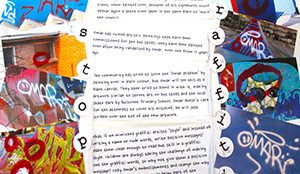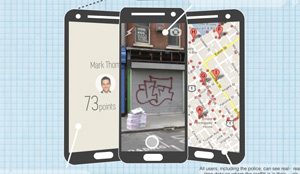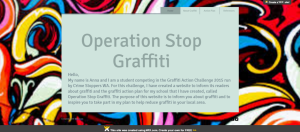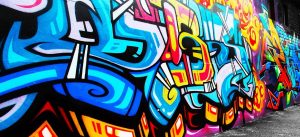Notable Entries
Poster by Amelia Pengelly

Amelia’s winning idea was to copy the graffiti vandal’s style and tag of “Omar,” but legally and artistically spray positive messages instead of rude ones. This positive association is not what a graffiti vandal wants, so it may discourage them from repeat offending.
Phone App by Robbie Glyde
Encourage members of the community to take photos of graffiti in their area to load onto a smartphone app which will then show police the location by GPS. If it’s the first time a photo of a specific piece of graffiti has been received, the photographer can accumulate points that can be exchanged for rewards.
Website by Anna Bullard
Anna created a website and graffiti action plan called Operation Stop Graffiti. This was intended to educate her peers, to create a presentation explaining the difference between graffiti and urban art, hold a class brainstorming session looking at why people do graffiti, and inspire students to take part in the Graffiti Action Challenge.
Print Presentation by Malavika Panicker & Winnie You
This team focused on raising funds and developing new graffiti removal solutions. They wanted to pre-empt the issue by painting murals on graffiti-prone surfaces and restrict the sale of aerosol spray cans. Their plan is to spread awareness about the issue of graffiti vandalism through print and social media.
Mural by Amelie Warburton, Claire Madlener & Hannah Burt

This mural displays a diverse group of people from different cultures holding hands with a map of the world behind them. This was aimed to bring a sense of belonging into the community and therefore reduce feelings of isolation and graffiti in the area.
Written Ideas by Sreya Aremanda & Jaanvi Patel

Government-funded weekly sessions for troubled teenagers would provide an outlet for them to explain their issues and express their feelings. Monthly art classes and an annual community event would allow people to create urban artwork in legally allocated locations, which would earn them greater public appreciation.
